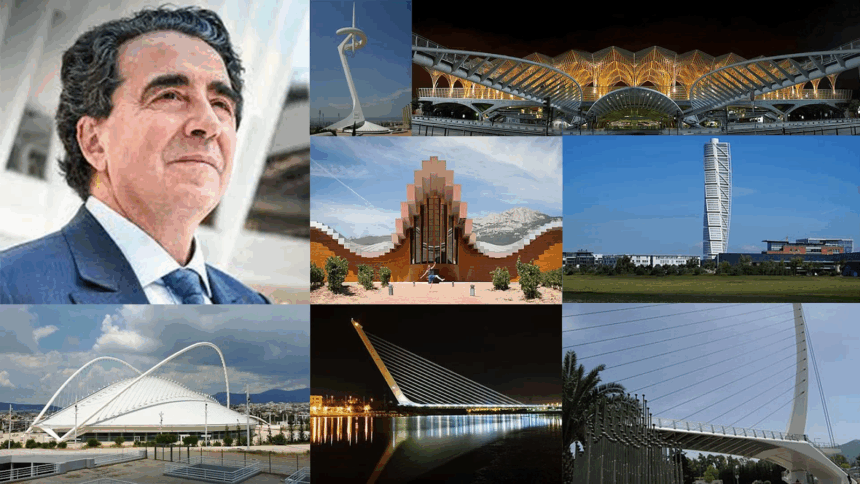Santiago Calatrava, born in 1951 in Benimamet, Spain, began his creative path as an aspiring sculptor. At 17, he considered studying at the École des Beaux-Arts in Paris but soon returned to Spain, drawn instead to architecture. He completed his degree at the Polytechnic University of Valencia and pursued civil engineering at the Swiss Federal Institute of Technology in Zurich, earning a doctorate. This unique combination of art and engineering shaped his approach, allowing him to conceive forms that are both structurally sound and visually expressive.
“Architecture and engineering are two aspects of the same process. One cannot exist without the other when the aim is to create forms that move and respond to their environment.” – Santiago Calatrava
Sculpting Light and Movement
Milwaukee Art Museum, Wisconsin | Picture Courtesy- Encyclopedia of Milwaukee
Calatrava’s work is instantly recognisable for its dynamic lines, curves, and elements that suggest motion. He draws inspiration from human anatomy, birds, and other natural forms, translating them into structural solutions that feel organic yet meticulously calculated. The Milwaukee Art Museum in the United States exemplifies this approach. Its Quadracci Pavilion features a movable winged roof that opens and closes according to daylight, creating a kinetic dialogue between the building and its surroundings. The Turning Torso in Malmö, Sweden, rises 190 metres and twists as it ascends, evoking a human figure in motion while challenging conventional skyscraper design.
Bridges That Speak and Flow
Margaret Hunt Hill Bridge, Dallas | Picture Courtesy- S-Steel
Calatrava’s bridges demonstrate his talent for combining functionality with artistry. The Margaret Hunt Hill Bridge in Dallas employs a single arch that carries both structural and aesthetic significance, while the Peace Bridge in Calgary features a helical form that turns pedestrian movement into a sculptural experience. These structures do more than connect two points; they interact with the cityscape, offering visual excitement and a sense of motion that elevates the ordinary experience of crossing a bridge.
Urban Landmarks and Public Spaces
Oculus/ World Trade Center Transportation Hub, New York | Picture Courtesy- skanska
His work is not limited to bridges and towers. The World Trade Center Transportation Hub in New York, known as the Oculus, showcases Calatrava’s ability to transform transit spaces into symbolic architecture. Inspired by a bird in flight, the terminal conveys hope and renewal while providing practical circulation for thousands of commuters each day. Each structural element, from the soaring arches to the skylights, serves both an engineering function and an expressive purpose, blending movement, light, and form.
Recognition and Challenges
Ponte Della Glass Bridge, Venice | Picture Courtesy- Curbed
Calatrava’s achievements have earned him global recognition, including more than twenty honorary doctorates and numerous architectural awards. His designs have been featured in exhibitions around the world, highlighting their influence on contemporary architecture. Nevertheless, some of his projects have faced criticism for cost overruns and maintenance issues. The glass flooring of Venice’s Ponte della Costituzione required replacement, and the Oculus exceeded initial budgets and timelines. These challenges reflect the delicate balance between visionary design and practical execution, yet they have not diminished the admiration for his creative ambition.
Inspiring Generations
Turning Torso high rise structure, Sweden | Picture Courtesy- Discover Walks
Through his career, Calatrava has influenced architects and engineers alike, demonstrating that technical precision and sculptural creativity can coexist. His emphasis on kinetic forms, natural inspiration, and structural elegance encourages designers to explore new possibilities. Projects like the Turning Torso and Milwaukee Art Museum continue to serve as benchmarks in combining engineering excellence with architectural imagination. Students and professionals studying his work gain insight into how buildings and bridges can move, interact with light, and evoke emotion without sacrificing functionality.
Calatrava’s designs invite viewers to engage with architecture as an experience rather than a static object. Every line, curve, and moving part contributes to a dialogue between the built environment and those who inhabit or pass through it. His architecture reminds us that engineering is not merely technical but can convey artistry and emotion. While some of his works provoke debate, their ingenuity and visual impact have reshaped modern architecture. Through these structures, he continues to push the boundaries of what is possible, inspiring a new generation of architects and engineers to consider movement, form, and light as central elements in design.

Ar. Pranjali Gandhare
Architect | Architectural Journalist | Historian






